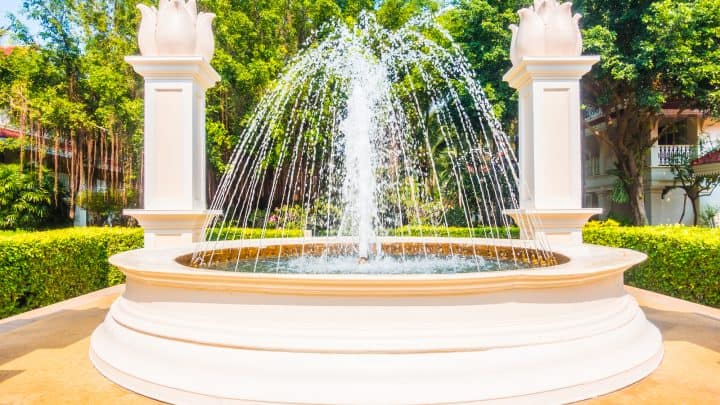The sound of water running is soothing. Outdoor water features also add a point of interest to an otherwise ordinary landscape. However, many homeowners wonder how to power these features and want to know if running them will dent their electricity bills.
Most outdoor water fountains require wired electricity or solar power, with the exception of gravity-fed fountains. Hardwired fountains use electricity from the grid and are connected to your home’s power supply. Their solar-powered counterparts either use built-in solar panels or draw power from your home’s solar energy grid.
Even though outdoor fountains do not use a lot of electricity, there are ways you can further reduce their operating costs to save on your electricity bills and benefit the environment.
Read on for an insightful discussion as I provide estimates of how much energy outdoor water features consume and how you can save energy while running these appliances.
Do Water Fountains Use a Lot of Electricity?
Water fountains generally avoid using a lot of electricity by putting out low horsepower and passing little water. In fact, most small- and medium-sized water fountains use the same electricity as a light bulb. Their larger, higher-end counterparts with impressive sprays use more electricity.
Simple water fountains cost less than $50 per month in electricity bills. As you’d expect, solar fountains are cheaper, and sophisticated ones are more expensive to run.
Considering the size of the Pump
The size of the pump determines how much energy a water fountain uses. Check the wattage of the pump and use this number to calculate on your local utility provider’s website the amount of electricity the fountain will use.
I will explain how you can calculate the cost of running your water fountain in a later section of the article.
If you have outdoor water fountains as a part of your swimming pool, you can use the pool pump for the fountains or water jets. But if you want to add more power to your water fountain, you’ll need a booster pump.
How Much Sun Does a Solar Fountain Need?
A solar fountain with a powerful motor and a large, impressive spray needs a full day of sun to work best. However, simple solar-powered outdoor fountains have a low wattage of 1-15 watts and don’t need a full day of sun to run. If you use a separate solar panel, you can place the fountain in a shaded area.
Because simple solar water fountains do not use much energy to run, you can install them even in areas that do not receive much sunlight.
Think About Battery Packs
You can add a battery pack to store power and run the fountain even on cloudy days. This makes a solar water fountain almost free to operate.
The solar water fountains that do not have a battery pack run only when the sun is shining.
Should Water Fountains Run All the Time?
We wrote about this extensively in another article very recently. If you’re concerned about the health of your continuous flow water fountain, consider reading it here.
The TLDR is that running a water fountain pump around the clock does not increase your electricity bills by much if you use a simple feature with a small pump.

How To Calculate the Electricity Your Water Fountain Uses
Water features typically do not gobble up electricity. However, some consume more power than others, so you might want to check how much electricity your water fountain is using.
We actually wrote a long-form article about how much water fountains cost to run, so please check that out if you’re curious. However, if you’re in a rush continue on below.
Here’s how you can calculate how much electricity your water fountain uses:
- Find out the horsepower of the pump. The sticker on the pump usually specifies the horsepower of the pump. It also mentions the values for volts, watts, amps, and the volume of water the pump can move in an hour.
- Find out the cost of energy per watt-hour. Your power company charges you a certain amount of money for every watt-hour of electricity you use. You can visit your local power company’s website or use this appliance energy calculator to determine the cost per hour of using electricity in your region. Enter details like horsepower and wattage to calculate the cost per hour of running your water feature’s pump.
- Multiply the pump’s usage time with cost per watt-hour. You know how much your energy provider charges for every watt-hour of electricity used. Multiply this number with the number of hours you intend to run the pump throughout the year or every month. The result is the total cost you will incur in a month or year to run your fountain.
For instance, it costs $0.12 per hour to run the pump, and you usually run the pump every day for three hours. So, it will cost you 36 cents per day or $10.80 every month to run the pump.
How To Save Energy When Using Water Fountains
In addition to the positive correlation between the size of the pump and electricity costs, your energy bills are bound to rise by varying amounts depending on:
- How long you run the water pump and the source of the electricity (i.e., electricity vs solar).
- Your fountain’s energy requirements.
- When you run the pump.
Here’s are a few ways to save on electricity costs when operating water fountains.
Use Solar-Powered Water Fountains
Solar energy lets you run your outdoor water fountains at almost no cost and also decouples the fountain from your home’s electrical supply.
You can use a water fountain with its own solar panel or connect the device to your home’s electricity supply (assuming your home is also powered by solar).
Also, some water fountains come with built-in solar panels. If yours doesn’t, you can buy external solar panels and connect them to your device.
Don’t Forget to Clean Your Solar Panels
Remember to wipe the solar panel clean regularly with a soft cloth. This ensures the panels can make optimum use of the sun’s rays that hit them.
Additionally, consider adding a battery pack to store the collected energy. This way,you can continue operating your water fountain on renewable energy even when the sun isn’t shining.
Choose Outdoor Fountains That Need Less Energy

Large-sized water features with impressive displays need powerful pumps that use a lot of electricity.
For instance, a water fountain with computerized controls that synchronize music to water flow or animated light rays uses more power than a simple system where water trickles down a series of stone steps.
How Large is the Spray?
Similarly, a spouting fountain that shoots or sprays water into the air to create a spectacular plume-like effect uses more electricity than a wall fountain where water cascades down a flat surface.
Strike a balance between horsepower and features to save on utility bills. You can install a simple water feature if you have other landscape elements to serve as points of interest, such as an ornamental pillar or post, a rockery, or a statue.
Run the Fountain During Off-Peak Hours
Some power companies recommend running your non-essential appliances during off-peak hours when other people are not using a lot of electricity.
For instance, people in hot, humid climates tend to run their air conditioners in the afternoon. If you live in such an area, it would be wise to power off your outdoor fountain during these hours.
Many power companies have time-of-use residential rate plans to encourage consumers to use electrical appliances when the stress on the grid is low. Running your water fountain during off-peak hours lets you save energy bills by allowing you to take advantage of cheaper electricity prices.
Run the Fountain Less Time
The downside to the above is that you may not be able to enjoy your fountain as much during off-peak hours.
If this is a deal-breaker for you, you can still lower your electrical consumption and, by extension, your electricity bill by running the pump for less time. Determine how many hours you actually need the fountain in operation and simply turn it off when it’s not in use.
You could even set this system up on a timer to reduce electrical consumption with no added effort. This will reduce the amount of electricity and potentially help you use less water.
What is a Gravity fed fountain?
Gravity fountains, also known as Heron’s fountains, date back to 4,000 B.C. They are a closed system that uses air pressure to push water back up through a series of tubes. They are completely disconnected from your house’s power supply and lack a pump or mechanical parts.
Final Words: Choose an Energy-Efficient Fountain
Outdoor water features can be both electricity- and sun-powered. The latter are more energy-efficient than those that run on electricity.
However, you can install an outdoor fountain that runs on electricity and still be energy-efficient. Keep the following in mind:
- Choose water fountains that don’t need a powerful pump to run.
- Run the pump during off-peak hours.
- Keep an eye on how much energy the water feature is using.

